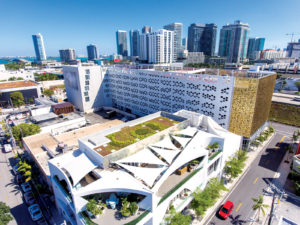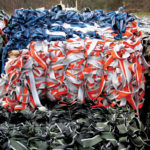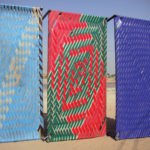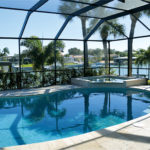
If there were a formula for writing a hit song, we could all do it. Efforts have certainly been made to figure out just what’s required to reach the top of the charts, but there simply isn’t a single defined path that can be taken to ensure musical success. In manufacturing, businesses that look to innovation as part of a growth strategy quickly realize that there are many different blueprints they can use—the key is finding the right versions to fit the products, the markets, the company and the industry.
We spoke to a number of companies, of different sizes, involved in different aspects of the fabrics industry, asking how innovation is integrated into their organizations. Each company has found distinct strategies for success.
Separate the process
“Improving the products you make is a consuming job,” says Mark Mordecai, director of production innovation for Globe Manufacturing Co. LLC, Pittsfield, N.H., which makes protective gear for firefighters. “There is always the next improvement to gear you are supplying to the market.”
Mordecai wanted to discuss the topic of product improvement not because it’s important to Globe—although it is—but instead because it’s something he says can actually get in the way of innovation.
“If we don’t separate out innovation, we end up being stuck in the improvement process all the time, and we never get to that innovation space,” he explains.
To that end, Globe employs a new product development process that is distinct from its product improvement process. “A lot of people work on both sides,” Mordecai says, “but the way we make sure we keep an eye on innovation is to have a separate process for developing new products.”
Globe starts both processes with feedback from thousands of customers, Mordecai says. “We’re immersed in their world, and we get input from them every day.” Complaints, concerns and issues are addressed in the improvement process, while ideas for new products are slotted into the development process.
Customer input is combined with internal research and ideas, Mordecai explains. “We can’t do everything, so we take our pile of ideas and sift through and prioritize them. We want to make sure that we are moving forward with projects that have the opportunity to be the most innovative and effective at solving real problems.
“This is the opportunity to invent something,” he adds, “to take it through the design and prototype stages, verifying that it meets regulatory standards and can be reproduced consistently and cost-effectively. Then it needs to be validated by the customer. There are a lot of things that need to happen, but it’s all about solving problems in new ways.”
“The fact that my job exists tells you how important innovation is here,” Mordecai says. “We’re fortunate to be owned by a company [MSA Safety Inc.] that celebrates it. That’s the most important piece right there—to be in a culture where innovation is a core value.”
Globalize knowledge
“Innovation is part of our culture, and it spans across our organization,” says Maura Misiti, senior marketing manager for Saint-Gobain ADFORS America, Grand Island, N.Y., a company that makes technical textiles for the construction and industrial markets. Saint-Gobain, the parent company of ADFORS, is headquartered in Paris, with numerous divisions and brands located in more than 60 countries.
Misiti says one way the company fosters innovation is by employing research and development functions in both central locations that serve the entire organization and at local offices.
Saint-Gobain has eight different research centers, including one in Northborough, Mass. “The Northborough location is one of Saint-Gobain’s largest research and development centers, and works with many different Saint-Gobain brands, ADFORS being one of them,” Misiti says. “By working with many different divisions and materials, there is a sharing of knowledge that allows us to create the best solutions for our customers.” There is also a dedicated team of researchers who focus solely on the ADFORS brand, she adds.
In the local offices, Misiti says, “Our project teams are always comprised of people from various disciplines within the business. That collaboration brings different pieces of knowledge together and allows us not only to move quickly, but to develop customized solutions.”
“Innovation occurs when you get representatives from different areas of the business, with different points of view, all in one meeting,” adds Misiti’s colleague Lindsey DeMarchis, a marketing communications specialist.
It’s worth noting that Misiti came to marketing from product line management. “The company thinks it’s important to capitalize on the technical experience that a lot of employees have,” DeMarchis says. “In a lot of companies, it’s rare to find a marketing manager who has an engineering and technical background.
We think it really helps here when everyone is close to the product.”
Keep an eye on industry trends
Pvilion, based in Brooklyn, N.Y., designs and manufactures flexible PV solar structures and products ranging from solar-powered charging stations to solar-powered curtains, building facades and clothing.
“What we do, fundamentally, is integrate solar cells with fabric,” says Colin Touhey, Pvilion’s co-founder and CEO. “We build products out of those materials, from backpacks and clothing to stadium roofs and large tensile structures and everything in between.”
Touhey says innovation at Pvilion begins with having its finger on the pulse of the solar technology industry. “We’ve been doing this for 20 years, so we know every manufacturer and we know all the possibilities and what works and what doesn’t,” he says.
But while Touhey and his co-founders, Todd Dalland and Robert Lerner, may have plenty of thoughts about what to do with that information, Pvilion’s innovation is largely driven by the market.
“We have a lot of ideas in the back of our minds that we’re not going to pursue unless there is someone in the market saying ‘we want this thing,’” Touhey explains. “We would like to partner in the product development process rather than go it alone.”
For example, he says, “We’re seeing a lot of companies that make outdoors products who want solar-powered versions of those products. That’s the market telling us what we need to do.”
When that happens, Touhey says, “We look at how we take the technology and implement this idea. What are the challenges? What are the reapplications of the technology? How do we have to modify it? The best applications are where we barely have to modify—when we can simply implement the technology into a product line.”
Each project the company undertakes helps it innovate, Touhey says. “We think of every custom project as a product,” he explains. “As we build that project, we’re thinking of how we build the second one and the third one and the 100th one. We understand there’s a market for this and we can make the second one easier and better.”
Aim for cooperative engagement
When your business relies on innovation, it’s probably wise to be able to take the bad with the good. Not all innovation is successful. Such is the case with EnKad Sciences in San Diego, Calif., which
helps businesses recycle and repurpose fabric waste.
“What we do is look through the spectrum of problems businesses have disposing of their waste and figure out which ones we can have an impact on,” says Bimal Kad, Ph.D., EnKad’s owner. “But we fail more often than we succeed.”
The issue, according to Kad, is that at the same time companies are making greater efforts to dispose of their waste in a way that is friendly to the environment, it has become more difficult to find economically viable solutions.
“The kind of waste we get involved with, nobody wants to do anything with in the U.S.,” Kad says. So the vast majority of the textile waste EnKad acquires goes offshore, most of it to India.
An example is waste generated in the trimming of PVC-coated fabrics. “That edge trim [selvage] was historically dumped in a landfill, back when it was fairly cheap to do that and there wasn’t any stigma attached to it,” Kad says.
EnKad sends millions of pounds of the PVC-coated selvage trim waste to India for use in making the cot beds (called charpai), a ubiquitous piece of furniture there, a rural necessity and urban convenience. Use of the coated fabric helps increase the charpai’s useful life, with no maintenance, beyond the three or four years expected when they are made of twine.
But even when an innovation such as that makes a lot of sense, Kad says, “This is a country where the majority of the population is still relatively poor, and it takes a certain amount of effort to convince them to try something new.
“It’s virtually impossible to convince the guy who makes the cots that he should use this new material, so we push this development out in the field by becoming a customer ourselves,” he explains. “He makes me 200 cots and I buy them and distribute them. The idea is to propagate the use and make people feel comfortable with the product.”
Sometimes, however, “poorer economies look at this waste as an opportunity and tend to innovate themselves,” Kad says. “The ideas and motives can actually come from their end. We will have one fancy idea and they will come up with a totally different idea that is a much better fit for their local environment.
“This mutual and cooperative engagement is key to innovation in our waste repurposing and recycling efforts,” Kad says.
Engage with end-users

produces GlideWear, which includes a line
of clothing that protects the skin of children
with Epidermolysis Bullosa, a painful fragile
skin condition where even the slightest
amount of friction causes severe blistering.
Photo: Alison Bents Photography.
Tamarack Habilitation Technologies Inc., based in Blaine, Minn., manufactures innovative, clinically effective and durable solutions to provide and restore mobility and comfort for its customers. Its brands include ENGO®, a line of blister prevention products, and GlideWear, a two-layer, low-friction fabric that’s used in medical and sports applications to protect skin from harmful friction and shear.
GlideWear, which works by gliding smoothly against itself, absorbing friction and shear and protecting skin, is a good example of how innovation works at Tamarack, according to Caroline Portoghese, senior clinical and education specialist.
“We introduced GlideWear to solve a specific problem and then discovered there were so many broader applications for that specialty fabric,” Portoghese says. “I’m still surprised by the many different ways that the product can be used.”
Her colleague, Tamarack director of marketing Kimberly Sanberg, says those discoveries most often come from clinicians. “They see a problem and think about creative ways we could help the end user solve those problems,” she says.
“It’s easy to be internally driven and have your innovation only come from inside the company,” Sanberg says. “What we do really well as a company is talk to clinicians and end users and really get their feedback.”
At Tamarack, feedback comes from clinicians and end users about products already on the market, but also during the development of new products. “Otherwise,” she says, “we might get all the way through a product development process and realize we don’t have a great product. This way, we’re set up for success.”
“We learn a lot from real people,” Portoghese says.
A recent example of GlideWear innovation came when the company started working in 2015 with a four-year-old Minnesota girl with epidermolysis bullosa. Tamarack’s clinical team designed custom clothes that would protect her armpits, knees, elbows and back from the friction that causes blistering for people with this condition. Since then, Tamarack has launched a new line of garments and support surface products for other children with epidermolysis bullosa.
Jeff Moravec is a freelance writer from Minneapolis, Minn.

Two “big picture” problems are driving innovation and change in fire
service fabrics today, according to Mark Mordecai, director of production innovation for Globe Manufacturing Co. LLC, Pittsfield, N.H., which makes protective gear for firefighters.
The first is cardiovascular strain. “These are ‘industrial athletes’ performing a very physical job who arrive at a scene that requires heavy aerobic activity with no warmup time,” Mordecai says. “And they’re wearing gear that keeps their body from cooling itself effectively in spaces that are overheated.”
Second, firefighters are exposed to toxins from the smoke and the environment in which they work. “We have a much better understanding today that a fire scene is a ‘hazmat’ scene,” he says. “The by-products of combustion are carcinogenic, and there are concerns they may be contributing to a wave of cancers that are showing up in the fire service.
“Marry those two problems together and it’s now ripe for innovation,” Mordecai says. For Globe, that means focusing on developing new gear
that is lighter, more flexible and body-conforming, while adding a layer
of protection against particulates.
“It all comes out of real needs and problems,” he adds. “If you’re able
to come up with innovative solutions, you can make a real difference.”

The increase in catastrophic storms in the past few years has spurred innovation at ShadeFLA, a boutique awning company in Miami, Fla., according to Margueritte Ramos, company president.
“Products engineered for high winds have become critical to our success,” she says. “With much of our work in Florida and the Caribbean, we always have to be mindful of how our products will hold up against winds as high as 175 mph.”
Staying on top of innovations in the market means we can propose solutions to our clients that they didn’t even know existed,” Ramos says. “We pride ourselves in being ahead of the curve.”
While the damaging storms have required ShadeFLA to change its product mix, it’s also meant a “massive increase in demand,” Ramos says, as hotels and resorts rebuild and bring their architecture up to current codes.
“Most of our projects are highly customized, the right fit for the client,” she adds. “But all the shade systems have to be able to withstand that next big storm.”
 TEXTILES.ORG
TEXTILES.ORG






